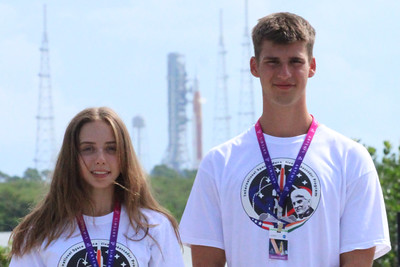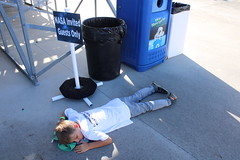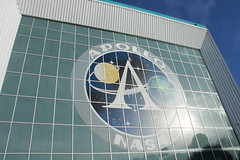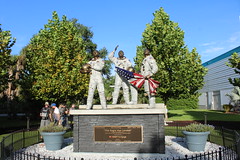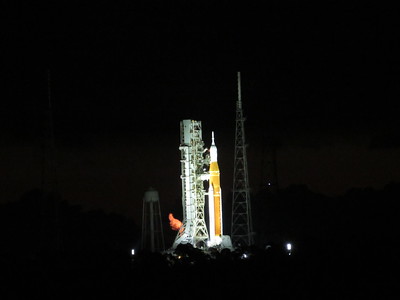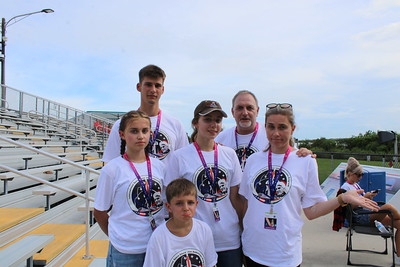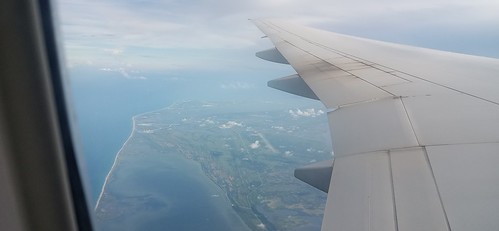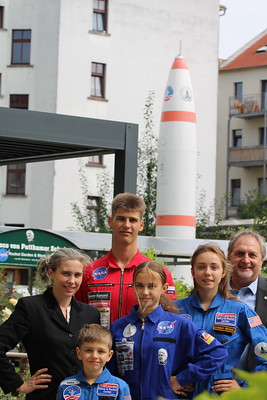| Excursions - VIP Tours |
Bericht vom SpaceX Start mit Starlink
5.9.2022, Cape Canaveral, Ralf Heckel
Fotos Cosmas Tagebuch Rovernauts Startberichte Raumfahrt Concret Werner-Heisenberg-Gymnasium
Dim lights
Nach 2 Startabbrüchen und anstrengenden 2 Wochen haben unsere Schüler und Studenten einen Bonus verdient. Natürlich ist dieser Joker von Anbeginn im Ärmel. Heute gab es einen SpaceX-Start gratis.
Aber zunächst ist es wichtig die gemachte Erfahrung an der Schwelle einer neuen Hardware auch machen zu müssen und zu verarbeiten. Da fiel mir ein sehr guter Post von Jim McDade auf, der auch zum engen VIP-Kreis um diesen Artemis-Testflug gehört. Der schrieb, dass er einen Startabbruch als „Level 3 Erfolg“ wertet und dies umschrieb er so:
Level 1: kompletter Missionserfolg
Level 2: Während des Fluges geht irgendwas kaputt und die Mission kann nur teilweise ausgeführt werden oder
muss abgebrochen werden (wie bei Apollo 13 oder die erste Periode von Hubble)
Level 3: ein Startabbruch mit dem Erhalt aller Hardware und auch Menschenleben
Ein Misserfolg ist erst der komplettverlust von Hardware und auch Leben (wie bei Challenger und Columbia oder den Privatunternehmen Scaled Composites, Antares 2014 oder SpaceX 2016).
Zum Level 1 und 2 haben es in der bemannten Raumfahrt bislang nur Apollo und die frühen sowjetischen Flüge vor Sojus geschafft. Auch der erste Testflug der Saturn V wurde von einem Triebwerksausfall in der 2. Stufe behindert, konnte aber durch längeres Brennen der verbliebenen Triebwerke erfolgreich abgeschlossen werden.
Verlustreich waren für NASA der Tod von 14 Astronauten durch 2 Space Shuttle Katastrophen. Diese waren möglich, weil Übermut zum Verlassen der eigenen Sicherheitsregeln führte, die bis dahin seit Apollo durch Wernher von Braun Standard waren. Daraus hat man gelernt und hat auch die zivile Raumfahrt bewusst aufgesplittet in einen wissenschaftlichen und einen privaten Zweig. In Russland gab es diese Erfahrung bei den ersten Sojus-Flügen auch. Eine Liberalisierung der Raumfahrt hat dort aber aus heute bekannten Gründen nie stattgefunden. Und inzwischen kann ich die Vorbehalte der Amerikaner für die Unterstützung russischer Raumfahrt-Technik wie in den letzten 2 Jahrzehnten auch gut nachvollziehen.
Seit 2005 wird das als COTS (Commercial Orbital Transportation Systems) bezeichnete Programm schrittweise durch die NASA vorangetrieben und Regelfrachten durch die Förderung privater Vertragspartner ausgegliedert. Dies führte auch zu einem Ressourcenpool an Fachkräften aus dem Shuttleprogramm mit einem sozial intelligenten Transfer zur Privatwirtschaft. An diesem Programm arbeitete auch Prof. von Puttkamer mit der da sagte: „Wir werden da sehr genau hinschauen wenn es eines Tages mal darum gehen wird, Astronauten mit privaten Raumfahrzeugen zur ISS zu fliegen.“ Inzwischen ist diese Utopie von damals Realität. Man legt bei COTS besonderen Wert auf mindestens 2 Konkurrenten. Inzwischen ist zumindest einer davon reichlich bekannt – SpaceX. Andere machen gerade noch ihre Hausaufgaben.
Und genau diesen Joker habe ich für die Schüler in der Tasche.
Völlig überraschend lud ich zur Tour an einen anderen Beobachtungspunkt nahe der US Space Force am Port Canaveral ein. Einige der Teilnehmer hatten nicht auf meine Anweisungen gehört und von sich aus ihre Flüge anders gebucht als vorgegeben. Sie wollten Zeit sparen und reisten bereits gestern ab. Nun sitzt also eine Handvoll übrig gebliebener im Bus und wir fahren zum Raketenstart. Die anderen sitzen im Flugzeug und dürfen nun nachdenken was für sie in Zukunft Priorität hat. Aber alle haben eine weitere Chance auf einen nächsten Startversuch der Artemis 1. Die US-Behörden haben 6 Monate die Personalien unserer eingeladenen Teilnehmer durchleuchtet und zugestimmt. Diese Personen bleiben dann auch die einzigen Ausländer, welche den Start erleben werden. Es wird sich zeigen wie stark der Wille eines jeden einzelnen dazu ist. Er ist das Auswahlkriterium.
Es geht um die gigantischen Kreuzfahrt-Terminals herum in Richtung US Airforce. Nun steht da Space Force. Das alles war also nur ein Etikettenwechsel. Die Rasenfläche am Banana-River ist noch recht leer. 3h bis zum Start. Polizisten weisen uns ein. Das alles geht recht eingespielt und kostet auch keinen Eintritt. 2 kleinere Tribünen stehen schon bereit und ein riesiges unbemanntes futuristisch aussehendes Flugzeug ist als Denkmal ausgestellt. Es stammt aus den 1950er Jahren.
Es verbleibt genug Zeit zum Einstellen der Kameras. Die übrigen Schüler und Studenten vertreiben sich die Zeit mit Kartenspielen und allerhand Konversation, sodass ich immer mal kommen und zur Konzentration aufrufen muss. Der Buffer ist eben voll, das Stresslevel bereits erreicht. Das ist für mich eine neue Erfahrung im Vorfeld eines Raketenstarts.
Es wird dunkel. Startfotos und zumal noch mit Team werden unmöglich. Der Startplatz LC 40 ist 10 Meilen (16 Kilometer) weit weg und die Rakete ist kaum zu sehen. Die Artemis ist noch etwas weiter weg, aber noch gut zu erkennen. Dennoch, für eine Fotolinse ist das alles nichts. Ich frage ob die Studenten ausrechnen können wie lange der Schall braucht, um hier anzukommen. Nach einigen Startschwierigkeiten kam die Zahl 48 Sekunden. Es wird also fast eine Minute die Rakete steigen und man hört nichts. Ich bereite sie darauf vor und gehe das Missionsprofil nochmal durch: Start, Trennung der 1. Stufe, Zündung der 2. Stufe, Landung der 1. Stufe auf dem Drohnenschiff.
Eine Landung einer Rakete! Ja das ist Joker 2. Das gibt es heute auch.
Bei T -5 Minuten beginnt der Livestream und mein Pad steht neben 6 Kameras die alles aufzeichnen. Es ist mein 2. Nachtstart. Beim ersten gingen alle Foto- und Filmversuche daneben. Es blieb ein Ereignis für die eigenen Augen und das war überwältigend. Heute soll es anders werden und ich muss viel schätzen und improvisieren, vor allem bei den Langzeitaufnahmen.
T 1 Minute, die Kameras werden der Reihe nach angeschaltet.
Start. Ein Lichtblitz zuckt durch die Lagune. Hell erleuchtet nun die ferne Rakete die Umgebung. Die wenigen Zuschauer sind außer sich und geben staunende Laute von sich. Mehr und die zirpenden Grillen sind aber nicht zu hören. Langsam steigt der Lichtstrich in der Ferne in die Höhe. Die Menge wird wieder ruhig und schaut gespannt auf das Licht. Es wirkt nun als bleibt die Rakete stehen. Aber das täuscht. Man hat im Dunkeln nur kaum einen Referenzpunkt. Der helle Strich beginnt nach einer halben Minute nach Osten, also nach rechts abzudrehen und steigt weiter. Die durchstoßenen dünnen Wolkenschleier erhellen.
Da kommt sanft ein Grummeln auf uns zu, welches schnell lauter bis zum ohrenbetäubenden Knattern wird. Nun wird es auch wieder unter den Zuschauern lauter. Ausgelassenes Gejole. Meine Kameras arbeiten im automatischen Langzeit- und Serienmodus. Ich beobachte den Livestream und wieder die Rakete. Die Flamme ist nun fast waagerecht und wird größer. Ihre helle gelbe Farbe wird dunkelrot. Nun tritt sie aus der Atmosphäre aus. Sie ist bereits 80 km hoch.
Jesco starrt gebannt hinterher. Er ist am Ziel seiner Träume – vorerst. Auch auf der Tribüne herrscht angespanntes Gucken. Das Licht verlischt bei 2:30 min. Ein „Ahhh“ geht durch die Menge. Jetzt ist Brennschluss der 1. Stufe. Kurz darauf zündet ein neues kleineres Licht. Das ist das Marschtriebwerk der 2. Stufe, die die Nutzlast nun in die Umlaufbahn bringt. Erleichterung.
Nun ist der Himmel dunkel. Nur noch im Stream sieht man wie die Rakete nun an Fahrt gewinnt und dabei das eine Triebwerk so SpaceX-typisch hellrot glüht. Es ist mein 3. SpaceX-Start. Den ersten erlebte ich im NASA-Headquarters in Washington DC am 18. April 2013. Es war mein Geburtstag und dies der erste SpaceX start zur ISS, damals eine Fracht. Die Administratoren in diesem kleinen Kontrollzentrum, bei dem Jesco von Puttkamer immer als ISS-Direktor in der Mitte saß, staunten und sagten „a loong burn“. Immerhin schafft es SpaceX mit nur 2 Stufen zur ISS und eine davon wird zurück gewonnen.
Der zweite Start war mit Schülern am Banana Creek, auch zu meinem Geburtstag, 2018. Damals wurde das Observatorium TESS ausgesetzt. Mit dessen Hilfe hat man bis heute Tausende von Exoplaneten entdeckt, darunter 5 erdähnliche Planeten. Wir sind also nicht allein.
Ein Kreischen geht durch die Menge. Man kann einen Lichtpunkt erkennen der nach unten fällt. Das ist die 1. Stufe der wieder zurück kehrenden Falcon 9. Die Brenndauer ist nicht lang, dann erlischt das Licht wieder. Falcon 9 taucht gerade wieder in die Atmosphäre ein und dies muss abgebremst werden. Ab nun übernehmen die typischen Gitter am oberen Ende der Rakete die aerodynamische Kontrolle und leiten die Rakete auf ihrer Flugbahn.
Das Aufsetzen auf dem Drohnenschiff ist nicht mehr zu sehen. Die Erdkrümmung und der Mangovenwald am Horizont machen das unmöglich. Aber im Livestream wird ein punktgenaues Aufsetzen auf das Schiff dokumentiert. Applaus!
Jetzt löst sich die Anspannung bei allen. Die Schüler und Studenten liegen sich in den Armen und finden kaum Worte. Freude und Tränen wechseln sich ab. Emotionen werden frei. Ja so ist das, und das ist völlig richtig so. Diese 2,5 Minuten haben sich nun in das Leben eingebrannt und dafür hat sich diese ganze Mühe gelohnt. Nun haben alle einen Autopiloten im Kopf und der steuert nun viele künftige Entscheidungen anders.
Wir fahren zurück. Im Auto ist Ruhe. Auch ich staune über die Tragweite der Entscheidung von Puttkamers die vor 17 Jahren mit COTS getroffen wurde und gerade jetzt das Leben von 9 Teilnehmern lebenslang prägte. Schon am nächsten Abend beobachten wir von der Pier aus eine schwebende Lichterkette am Himmel. Starlink ist geglückt, wiedermal.
There are no translations available. Lieber zwei Startabbrüche als ein Fehlschlag!
Während der Tankvorgang im oberen kleineren Sauerstofftank beginnt, ist es auf dem Flugfeld von Titusville noch dunkel. Wir waten durch hohes taunasses Gras zu dem Bussen. Frühes Licht der eintretenden Dämmerung skizziert die leichte Bewölkung am Himmel. Nur weit im Norden türmt sich ein Schwarz auf aus dem es gelegentlich blitzt. Es folgt die gleiche Prozedur wie schon zum ersten Startversuch. Auch wenn wir hier von aller Verantwortung und Druck befreit sind, fällt das alles schwer. Die Müdigkeit ist unser steter Begleiter, trotz genügend Pausen und Schlaf.
Das Licht blendet und macht einen Blick auf die Rakete schwer. Die ist nur eine dunkle Silhouette. Regenschirme versperren die Sicht, weil sich jeder irgendwie gegen die Strahlen unseres Zentralgestirns schützen will. Meine 2 Tshirts und die lange Hose sind schon nass. Die Kameras überhitzen. Nun beneide ich die Fotografen mit ihren langen Canon-en nicht, die mit Klappsitz und Stativ ihre einmal ausgesuchte Position nicht verlassen können. Denn die ist dann von einem anderen besetzt.
Der Sauerstoff-Tankvorgang ist abgeschlossen. Nun beginnt der Wasserstoff, die weit größere Menge. Grafiken mit Füllständen werden auf den riesigen Bildschirmen angezeigt. Regelmäßig werden Kommentare der Kommunikation des Wasserstoff-Teams mit dem Flugleiter durch die Lautsprecher gegeben. „Ja, man hat aus gutem Grund die Hosen voll und will ganz sicher gehen...“ – hätte Prof. von Puttkamer nun gesagt. Wir aber suchen Schutz im Saturn V Center das jetzt geöffnet hat und die Schutz suchenden Massen aufnimmt. Hier unter dieser Saturn V hat alles angefangen. Hier waren Yvonne und ich vor genau 17 Jahren zum ersten Mal VIP-Gast der NASA und es wurde eine Gala zum Start der „Return to flight“ - Mission veranstaltet. Der damalige NASA Administrator Michael Griffin und der Chef der bemannten Raumfahrt und Astronaut William Ready sprachen bewegende Worte. Alle hatten die Bilder der am Himmel auseinanderbrechenden Columbia vor Augen und schwiegen. Neben uns in der Gruppe standen die Mitglieder einer Familie dessen Vater bei dem Sucheinsatz um Wrackteile der Columbia mit seinem Hubschrauber abstürzte. Inzwischen besuchte ich auch die Eltern der damals ums Leben gekommenen indischen Astronautin Calpana Chawla, in Delhi. Wir sind wegen unseres Engagements inzwischen Ehrenmitglieder der Astronaut Memorial Foundation geworden. Deren Ziel ist es Spaceeducation zu betreiben. Mehr dazu noch später. Beeindruckend ist die Vorführung des Apollo 8 Startes im ehemaligen Mission Control Zentrum. Das ist 4D-Kino mit vibrierenden Scheiben und wackelndem Fußboden. Jim Lovel moderiert am Bildschirm als alter Mann, während meine 15-jährige Tochter Cosma das 40 Jahre ältere Puttkamer-Buch „Apollo 8“ in der Hand hält, halb durchgelesen. Ob diese Zusammenhänge alle da oben jetzt ankommen? Die Berichte werden es zeigen. Als wir wieder heraustreten schlägt uns warme Luft wie eine Keule entgegen. Es ist kurz vor 11 Uhr, meine Kameras beschlagen sofort und es wird verkündet, dass das Wasserstoff-Team dem Startleiter den Abbruch empfiehlt. Der aber lässt mit einer Antwort auf sich warten. Zwar leeren sich bereits die Sitzplätze, aber andere bleiben wiederum trotzig sitzen. Inzwischen steht sie Sonne so hoch, dass die Rakete auch von unserer Seite etwas angestrahlt wird. Also nutze ich die Zeit für letzte Fotos mit Rakete und unseren Schülern. Dabei gelingen die besten Fotos. Doch es kam die Durchsage die kommen musste. Um 11:18 Uhr wurde der Abbruch verkündet. Manche Gesichter sehen nun wieder enttäuscht aus, andere nehmen es gelassen, haben ein dickes Fell. Nun spult sich wieder alles rückwärts ab und gegen 14 Uhr sitzen wir im Business-Bereich unseres Hotels und schreiben Berichte. Aber eines ist auffällig anders. Noch 2005 lästerte die USA Today bei jeder Startverschiebung mit Karikaturen wie „Gesundheit“. Das alles ist vorbei. Nicht nicht, dass es sowieso keine Tageszeitungen aus Papier mehr in den Hotelrezeptionen gibt, sondern grundsätzlich. Dabei ist unser Hotel schon eines der Besten. Hier residiert die japanische Raumfahrtagentur JAXA mit ihren Mitarbeitern, dem Präsidenten und einem Astronauten. Nein, Amerika steht geschlossen hinter der heutigen Entscheidung. Orlando-Sentinel-Online zitiert NASA Administrator Bill Nelson: „Lieber zwei Startabbrüche als ein Fehlschlag“.
Fire, roar, aborted takeoff - and a fabulous sunrise
The passengers in the buses are counted and then the column starts to move, while another column of empty buses already arrives again with escort. One can only see something through the front window. All the other windows are fogged up from the air conditioning inside, and from the warm, humid air outside. "Dew point undershoot" is what they call it, and you can't wipe it away. So, we continue through the night. Only dimly do we pass the Visitor Complex, the KSC guardhouse and the large assembly hall (VAB), crushed into water droplets.
Helicopters rattle, the governor of Florida Ron DeSantis arrives. VIPs are escorted. A large TV screen occasionally switches on to right of us, only to black out again. Living this moment, with the fueled largest rocket in the world in front of you is, awesome. Rumbling chirps. Suddenly murmurs and uneasiness burst into the silence. "There is a Fire"! Everyone cranks their necks, pulls out their cameras, shouting. I had just finished installing my tripod with a large telephoto lens and looked through it. Indeed - a huge dark red flame is flickering right out of the side of the launch tower. It's right where the hydrogen and oxygen tanks are. Oh sh.... ! The rocket is filled to the brim with fuel. That's will lead to a bigger explosion than Challenger 1986! And that was already huge!
The shock slowly subsides, the digital clock with the countdown counts down, and it quiets down again as another murmur goes round: "Ahhh......, Awesome, Amazing". The first rays of sunlight illuminate the various layers of clouds on the horizon in dark red, while above us it is starry and black. This spectacle changes every minute now. Orange hues are added and the clouds keep forming new black sculptures. In the center stands, blazing and steaming the new moon rocket - a breathtaking sight. It all looks like a work of art and yet it is a natural spectacle. The sun comes out and immediately it gets hot on my forehead. Now there will be a dry period where you just have to grit your teeth. It does not help anything; everyone has to go through it now! It becomes dazzlingly bright and hot. Suddenly, the rocket turns black and is standing there, like a silhouette in the backlight, with the fireball of our solar system to the right of it. This rocket could easily reach it, too. It is a great feeling to be allowed to stand at the side pillar of such an interplanetary bridge.
Sure enough, there's an unscheduled stop. The commentator explains that one of the engines isn’t cooling enough and that this "bleeding" is just being extrapolated by scientists with data. His voice pitch is unchanged as if this is a planned routine, so no one is really taking it seriously here either. But the countdown stops. Jesco loses patience with his camera and runs away to get a higher vantage point, from which he can see the clock better.
The mood on the bus was low, with only Kenneth, a 66-year-old teacher from Washington, continuing to take pictures on the bus and catching the only sunny photos of the rocket. The day had barely begun, but for us it was coming to an end. We checked into the new hotel and the 30 hours without sleep were made up for. After waking up it said: Start on Friday. I didn't even know what day it was, with 2 nights awake in just one week and a 6-hour time difference.
photos Cosmas blog Rovernauts Launchreports Raumfahrt Concret Werner-Heisenberg-School It's still about 3 hours to Orlando. I'm sitting on the plane again, after a break of 2.5 years. The Pandemic and the war have changed the world and our lives as well. After a 6 hour flight over London, flying just started feeling familiar again, as if the time since the pandemic began hadn't existed. Then I opened this pad and those last experiences I typed in here appear on the screen. There's a ticket to India with a stopover in Kiev. Now that airport is in ruins. My last travel report also looks at me warningly, Moscow February 2020. Like many, I had been deluded into believing that positive influence could be brought to Russia, something like a slow fall of the Berlin Wall. Since the outbreak of the war, I too had to realize that I was wrong. All the signs were there, but I didn't want to believe them. Now those 20 years of Space Education with Russia are history. Despots and their privileged henchmen are waging a war against their own and neighboring people and are taking our future into for this purpose. My huge list of friends in Russia has also thinned out. Former friends and even students I have grown fond of have allowed themselves to be blinded and in an attempt to explain themselves they themselves have become verbal and tangible perpetrators. Growing up in what was still the GDR, the memory of it was still there, and after 30 years since the fall of the Wall, I am aware that the old Russia has become taboo for me. The whole country has a long and sacrificial process of coming to terms with the past ahead of it, and I see little hope for a quick solution. Too much aggression, frustration and lies have built up over the last 20 years for that, and the people in power do not count on morality at all. Only the Russian people can change this process for the better and I fear that this will take a very long time. So, I am grateful for 20 years and countless trips to Russia, great experiences, a great time with our students and friends from space. Above all, they were one thing: unique. And I am gladly willing to resume these relations, to build a more peaceful Russia. But in order to do so, the Russian people must first do their homework, lose their fear of the despots, stand up and completely clean up the time of Stalin and Putin. There is a lot of work to be done. For a long time, I had admired the stability and reliability of Russian space travel. But now it is apparent that it has become an empty shell, too stiff and too intertwined with the military. Moreover, no real new innovation has been added since Korolyov. In contrast, NASA's new lunar program has picked up speed. In my estimation, it is precisely NASA's multifaceted orientation, including the promotion of private startups as service providers, that has given it its immense superiority over the Russian systems, which are now hopelessly outdated. Professor von Puttkamer's words thus resonate loudly when he told me in 2006: "We must put spaceflight on many legs and leave the day-to-day business to private service providers. That's the only way we as NASA can do what we should be doing, exploring space." So, for 20 years now, Yvonne and I have been working towards just that return to the Moon, getting hundreds of students excited about it, many of whom have now embarked on such a career. After 2 years of pandemic, we are still around and that is something to be proud of. So now I'm back on the plane heading for the USA. The first new moon rocket with the name Artemis 1 is to start. Again, there are several planes from many countries with the same one goal and many young people under our leadership. We will be meeting in the next few days, witnessing history firsthand and also writing it.
6 young engineers from Leipzig are at the forefront as NASA VIPs for the launch of Artemis 1 It is a promise made by Prof. Dr. von Puttkamer from Leipzig that has been kept 10 years after his death. When the Space Education Institute was first founded in Leipzig in 2005, he said: "If you stay involved with it, space will be open to you, and you will be right at the very front during the launch back to the moon". This was the same year that the first Space Shuttle had been launched again after the Columbia disaster. The professor was working on future long-term programs along with private participation, which are now coming to fruition. The couple, Yvonne and Ralf Heckel from Leipzig, were selected by him and invited to the first "Return to Flight" launch of the "Discovery" with the words: "Don't leave me hanging now. You are sitting next to the astronauts' families in the first row". But it took 2 flights to Florida and several launch attempts before the spacecraft finally took off. Now 17 years have passed and, since then, a school for young engineers with an environment-friendly campus with the name "Puttkamer" has been established in Leipzig, where Yvonne and Ralf have guided international pupils and students through the world of space travel on countless occasions. Here, 44 NASA rovers have been built by young engineers and three world championship titles were won at competitions. Leipzig has become a prestigious location for young international spaceflight talents. No one is closer: numerous pilots, space engineers and aspiring astronauts have begun their careers here. Additionally, the proportion of girls is even higher than that of boys. Currently, the next giant moon rocket, named "Artemis 1", is standing on the launch pad at Cape Canaveral, its height even surpassing that of Leipzig's 33-story business tower. The invitation for the team from Leipzig came directly from NASA headquarters and Professor von Puttkamer's work colleagues. Naturally, Yvonne and Ralf have been invited, as well as the current NASA rover of the 15-year-old experienced pilot, Cosma. Cosma is a member of the Youth Council of the US General Consulate in Leipzig. Her team, consisting of 8 to 17-year-old young inventors, represents not only Germany and the Free State of Saxony, but also the Jesco von Puttkamer School, Leipzig's Humbold Gymnasium, the Werner Heisenberg School, the Quartiersschule Ihmelsstraße and the 74th Primary School of Leipzig. In addition, Yvonne and Ralf are leading 20 other international pupils and students to the VIP area at Banana Creek.They all come from the fellow educational institutions TEC Monterrey Campus Cuernavaca, UNAQ, Mc Kinley high school and TecMantra (USA, Mexico, India). Among them is aspiring astronaut Jasleen Kaur and Tesla-engeneer Valeria Vazquez Zafra. Banana Creek is a lagoon merely 3 kilometers away from the launch site and it is exclusive for NASA's closest advisors and family members. Artemis 1 consists of the new heavy-lift rocket SLS (a symbiosis of the Apollo moon rocket Saturn V and Space Shuttle) and the Orion space capsule, large enough for a crew of 6 people. First, there will be an unmanned test flight around the moon and a re-entering of the Earth's atmosphere at 32 times the speed of sound. Earthquake sensors around the world will be able to register the launch and the fly-over. Three launch windows are planned for the 29.8., 2.9. and 5.9.2022. This rocket will be the most complicated machine to ever lift off from the ground. Hence, it is not yet clear whether the computer will interrupt the countdown. The first launch of the Space Shuttle took 2 years. Artemis 1 also has 5 different time windows between September and December 2022. All participants will be writing a blog which will be updated daily on www.spaceeducation.de and their Facebook fan page. On 25 August, the plane will take off with these "transatlantic ambassadors of the future".
Yvonne Heckel (47) Managing Director International Space Education Institute
Kenneth Lesley, McKinley Highschool Washington DC, USA |































